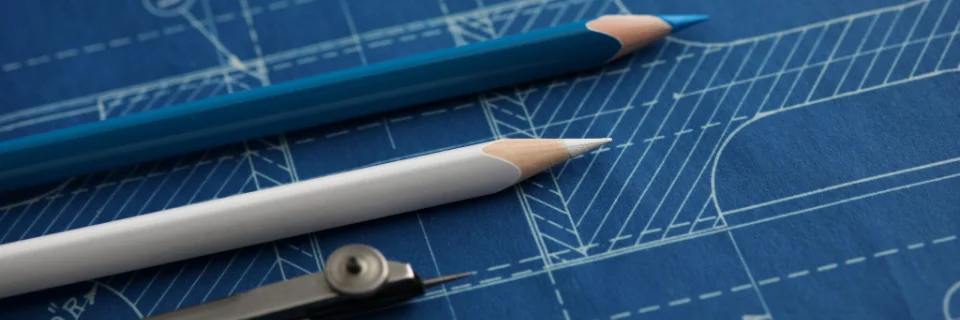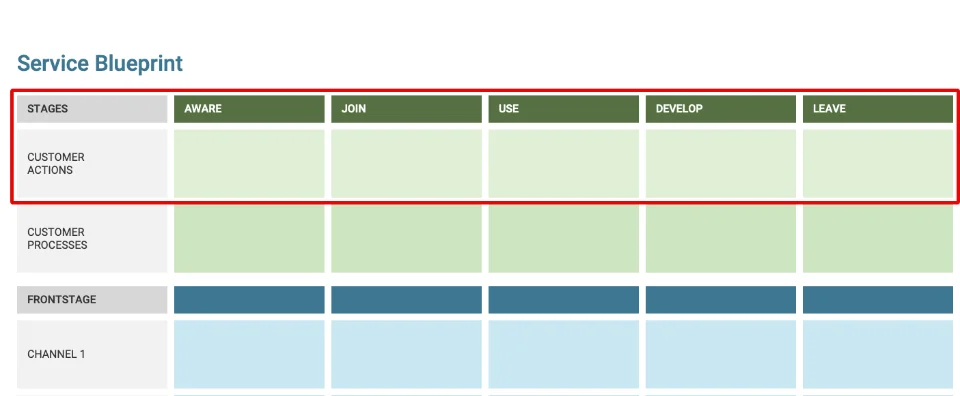16 Benefits of Service Design & Creating a Blueprint
Service Design and creating Service Blueprints as a team has tremendous ROI for many types of organizations. Here are 16 benefits we have seen from creating service blueprints for a many sizes and types of companies and non-profits.
Wes Hunt

Improves Communication Around the Whole Customer Experience
Managers and employees may have very different perspectives on the customer experience. Managers may be more focused on the business objectives and less on customer objectives, while frontline employees are more focused on customers.
Service blueprints enable better communication between managers and employees. Anyone that ever asked different teams to describe the overall process their organization uses for a service probably saw the large differences in mental models. Service blueprints effectively create a map that everyone can refer to and develop a common understanding around.
Makes Customer Experience Deliberate and Decreases Unintentional Experiences
Organizations and their developing customer experiences tend to grow organically. Most organizations will grow their teams deliberately, with some planning involved, but often the customer experience is developed on a per team basis without overall planning.
Small companies are able to communicate frequently and may not have any functional silos. Their CX will probably be fairly consistent; however, as teams grow and silos develop this will be less likely. Developing your CX ad hoc across teams without a thought to overall customer relationships will produce massive gaps. Scattershot customer experiences are rarely very good, but that is what happens naturally as companies and teams grow. Developing a service blueprint maps out how your service has grown and where it became incoherent.
By first mapping your current service design, and then creating an ideal goal state, you can deliberately plan how to get there.
Exposes Failures in Customer Experience Between Silos
Service blueprints break the customer’s experience into stages across your service. They are human-centric and not determined by your particular organization’s departments, product teams, or scrum teams which are all organization-centric. Your customer does not care about your silos, they only care about the value you are delivering to meet their needs.
A service blueprint creates visibility into what processes your organization is using to meet or miss each stage of the customer journey. What team(s) handles onboarding for the customer? What team(s) handle the hidden (to the customer) processes during onboarding? How many steps are duplicated by teams because they are siloed?
The blueprint will also show how those stages are visible to customers, for example documentation or marketing material, and addressed or shared by teams. Is the web marketing team using the same terminology as the support team? Is customer data being passed between teams to the customers’ benefit?
Builds Empathy for Both Customers and Frontline Teams
Because service blueprints focus your attention on the service from the perspective of the customer, naturally you will tend to develop empathy for them. You will see how many hoops, speed bumps, back-and-forths they have to put up with when dealing with your service.
What I did not expect when I first started doing service designs is how much a blueprint can expose the pain of the frontstage teammates. This is especially true for backstage employees when viewing how many steps their front stage teammates have to do in a stage for a single customer interaction. When a developer or IT admin sees how many systems a support person has to log-in to for a single customer stage, they can not help but sympathize. Are there manual processes that could be automated? Are there common steps that development could easily provide a tool for?
Builds Empathy for Backstage Teams
As above, the converse is also true. Frontstage teams often do not have a clear idea what the wizard is doing behind the curtain. In this case what backstage processes are happening in support of the stage.
A service blueprint calls out where the major effort is happening for other teams that you normally do not have visibility in. Frontstage teams can often stress what is delivering value to customers and should be optimized in the backstage. What stages get all the attention with background processes but do not deliver a lot of value to the customer?
Discover Tooling and Process Overlaps or Gaps
Although blueprints should be human-centric and focused on customer value instead of tooling, they still show where process and tooling is failing the supporting teams. When an organization grows their services organically with many independent teams, there tends to be both redundant tools (i.e. software licenses) or gaps. Even in tech-savvy teams I often see steps that could be handled by software that is already used elsewhere. For example, one team might be manually documenting customer phone calls when another team is using a CRM like Salesforce to handle contacts through the website.
By involving cross-functional teams in blueprinting the service, it gives them a chance to share knowledge with their teammates. I have seen developers coaching CX teams on how to do iterative improvement with retrospectives after a blueprint review. Blueprints will expose duplicate processes that could be consolidated. Do separate teams perform identical tasks? This should show up when defining the support processes.
Model How Team Changes Will Affect the Customer Experience
Change is the nature of business and human organizations. We are always in flux and adapting to conditions. Are your stakeholders frustrated when after changing team style or structures that there were unforeseen consequences for customers? How often do you plan a group trip without consulting a map or doing at least minimal planning?
Service blueprints are both your plan and guide when making organizational changes. If splitting a department across other departments negatively impacts customer value, would stakeholders still want to do it? At the very least, stakeholders will want to know what side effects are probably going to happen so they can weigh the consequences.
Because goal-state blueprints should be developed with input from cross-functional teams, there will be more opportunities to catch problems early. A service blueprint can be a kind of process prototype. Allowing stakeholders to build-test-learn with fewer consequences.
Gives Visibility Where Investment Will Have the Biggest Impact on CX
Resources are never unlimited for most of us. Time, number of employees, money to spend on support, and similar are all limited resources. Given multiple investment opportunities with -10%, 20%, and 50% ROI, most of us would choose the 50% option right? If we didn’t do any planning, and invested by chance there’s a chance we would pick the -10% ROI.
Deliberately mapping out your current and future customer experience helps you identify where the greatest return will be for the fewest resources. Are there stages that do not have any support but also do not provide customer value? Probably not a priority, but if left to their own siloed teams may spend all their resources on it.
Unfortunately individual teams may focus all their efforts on their own domain, even if it does not provide as much value if they helped a different department. Calling out these ad-hoc decisions and making deliberate choices with a human-centric perspective is the superpower of service blueprints.
Guides the Organization to Become Human-Centric Instead of Organization-Centric
Above a certain organization size, most of our efforts are spent feeding the beast. HR, accounting processes, tracking expenses, reports to middle management, etc deliver little direct value to customers. Unless there is a deliberate effort to shift focus, the tendency is to become organization-centric. How much of your time is devoted to dealing with non-customer visible processes? How many technology improvements deliver value to customers? Next time you see the dreaded org-chart, can you map customer needs to how that chart is organized? Will a customer care if their goal happens to be broken across two industry verticals as defined by multiple Marketing SVPs? The answer is no. As a consumer I am hiring your service to do a job for me. At the end of that job my goal has better be met by your service or I will move on to your competitor.
The service blueprint is from the perspective of all consumers of a service and focuses on their needs, not on tools or organizational goals. It forces stakeholders to answer how these needs are being met by the organization and be deliberate about matching business needs with consumers’.
Meet the Expectations of the Modern Customer in B2B or B2C
Consumer focused organizations are well accustomed to their customers’ expectations of cohesive services in the modern digital age. Consumers are now used to cross-channel experiences, interacting with companies via web chat, SMS, social media, and in person. B2C (business to consumer) companies have come to realize that in a crowded marketplace with little friction for consumers to switch providers, customer experience is a differentiator.
What is more recent is the same is happening in B2B (business to business). Companies used to (many still do) rely on vendor lock-in to trap their customers. Even with higher friction, many employees share their experiences with vendors publicly, even if they are stuck by their employer’s choices. More and more execs are turning away from elaborate (and misleading) sales demos and turning to their networks for feedback about potential vendors.
Customers are increasingly expecting a cohesive customer experience when interacting with any organization, whether it’s B2C, B2B, or a non-profit. Workers are increasingly expecting the same experiences from consumer applications in their work day applications. Even in fields with historically high vendor lock-in like healthcare are experiencing more bottom-up pressure from clinical staff to switch to better services.
Builds High-Value Relationships with Customers and Across Teams
Savvy business leaders know that a current customer is more valuable than a potential customer. There are many reasons for this that we will not go into, but in short current customers are more likely to reuse your services, use your other services, and recommend your services than people who do not know you.
By carefully defining customer needs in your blueprint, you focus your teams on meeting them across stages of the customer journey. You are more likely to both retain customers and get more recommendations from them. For example, imagine a customer who buys a widget from your sales organization, gets trained by online classes on your website, and then needs long-term support. Even if 2 of the 3 steps are perfect, the failure could wreck the whole experience and your chances of a long-term customer. At least if that failure happens at the wrong time for the customer. By making those transitions seamless and delightful, that customer will become your advocate.
The blueprint will help map out those transitions across teams and make sure no one “drops the ball” for the customer.
Match Organization Focus With Customer Needs
The service blueprint relates what the organization does with what the customer needs as a complete interaction with all of the customer-facing to support interactions included. If that relationship is not obvious, then stakeholders need to start asking critical questions.
Often businesses make an assumption that customers’ care what their goals and outputs are. We need to meet business goals of course, otherwise our livelihoods are in jeopardy. However, there needs to be a clear understanding of how business goals connect with customer needs. This is where I really appreciate service blueprinting, it is a wonderful way to clearly describe the complex interaction of need, value delivery, visible support, and behind-the-scenes support. How does each process connect from business goal to meeting a need? You may not address every need for every stage, but you want to be deliberate about what you are addressing or skipping.
Reduces Your Team’s Confusion Around How Customer Value is Delivered
Front stage and Backstage teams will often not think about customer value in daily tasks. Each team will probably have a different idea of what value they are delivering and may not connect it to a customer need.
Sometimes the discussion around the blueprint is more valuable than the deliverable itself. Miscommunication is the root of many disputes. At the very least it causes us to waste our valuable time focusing on the wrong activities. “Team alignment” can feel like an overused term, but when achieved alignment produces wonderful results. Creating visual maps that anyone on the team gets input on, and can refer to reduces misalignment at the very least.
Provides a Guide For Marketing Teams on Messaging and Where to Focus
This could be said of any team that creates a content strategy. However, marketing teams and to some extent support teams are often outsourced.
Service blueprints provide a reference for external teams on how to message customers (needs based) and what stages in the customer journey to focus on. If the organization’s teams decided a stage was critical to both business goals and user needs, then you want that marketing agency to nail the messaging.
Builds Cross-Functional Inspiration and Increase Innovation
There is a reason we tend to build larger and larger groups to tackle problems. As an individual contributor you have a limited skill set and amount of experience. Large groups have large amounts of diverse experience and skills. Silos can subvert this and reduce innovation.
There are many techniques to spur innovation within organizations, but a well chosen design activity with cross-functional teams works wonders. I highly recommend Jack Knapp’s “Design Sprint”. Although not directly related to service blueprints, the book does highlight and demo the power of cross-functional collaboration for innovation.
If you create a service blueprint without talking to people from different roles, responsibilities, and team functions, then just stop and throw your blueprint out. Whatever you created was not a blueprint, it was guess work built on assumptions. Service blueprints require the service designer to get input from cross-functional and cross-role team members. They also require insights from your target customers. It is one of the few design artifacts that map out everyone’s responsibilities from the perspective of customer need. By its very nature it involves cross-functional collaboration.
Provides a Complete View of a Service to Implement New Strategies
As mentioned earlier, the service blueprint is one of the only artifacts or documents that describes the service completely in a customer-centric manner. For strategy, the blueprint more importantly is human-centric, not just customer-centric. What I mean by this distinction is that there might be stages in the blueprint that involve needs and actions outside of being a customer. Maybe the business chose not to address this stage, they did not realize the need, or simply did not have the resources. In any event some stages call out from the perspective of a person, they have lives and needs outside of being a customer. What this means for strategy is the potential for adding new value for existing and potential customers.
Maybe no one in your industry addresses this stage. There are many successful startups that fit themselves into these missing stages that traditional players ignored.

